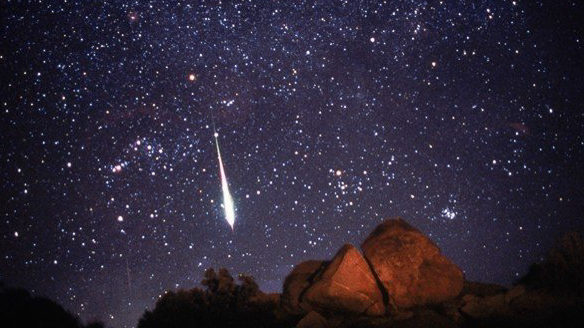
It is rare to find Zhang Bo without a metal detector, map and off-road vehicle.
Based in Shanghai, the self-funded meteorite-hunter spends his days researching meteor sightings and traveling the world to search for elusive — and valuable — fragments of rock.
Zhang, 37, is remarkably successful for someone with no formal training. He started researching meteorites after seeing a fireball streak across the sky in southern China in 2009.
In 2012, he began mounting expeditions into some of the world’s most inhospitable areas in Russia, France, the Sahara Desert and in China’s far-west Xinjiang, armed with a metal detector to scan the ground for rocks.
Since then, Zhang has plotted the location of meteorite landing sites. That, he says, has helped the Chinese authorities determine that the world’s biggest meteor field, which is 425 kilometers long, is in Altay, in China’s far-western Xinjiang region.
Zhang says he went to Altay around 20 times before finding anything significant. “Nine out of ten (times), you won’t be able to find anything,” he says.
China’s meteorite hunters
China’s vast plains and mountainous regions are popular hunting grounds for the nation’s meteorite enthusiasts. Some of the world’s biggest iron meteorites have been found there, including in Altay where Zhang competes with other hunters to find precious rocks.
Part of the appeal is the sense of adventure. Accessing remote areas requires serious equipment and planning — and with it comes the thrill of possibly finding something that pushes forward science’s understanding of the solar system.
For example, scientists found organic matter associated with water — the origin of life — in the “Zag and Monahans” meteors which crashed into Texas and Morocco in 1998, raising the possibility of the existence of complex organic compounds in space.
For many meteor hunters, however, the motivation is much more basic: Money.
After a fireball was seen soaring across the sky near the border of Myanmar and Laos in 2018, meteorite hunters raced to the region, armed with their metal detectors and hopes of striking it rich.
Confirmation that about 200 meteorites had rained down on a small village in Menghai country, Xishuangbanna, in China, which borders the two Asian countries, promoted such a rush that local authorities issued a notice calling for calm.
“Please take a rational look at the fall of the meteorite. Do not blindly want to achieve the goal of getting rich overnight by finding a meteorite. Good life needs to be created by your own efforts and dedication. Please treat it rationally,” the government notice said.
Days after the fireball sighting, alleged meteorites were being advertised online for as much as 50,000 RMB ($7,800) a gram.
Xu Weibiao, a meteorite expert from the Purple Mountain Observatory (PMO) in Nanjing, says meteorites can sell for even more than that — above $10,000 per gram.
“The rareness of the meteorite decides its market value,” Xu says. “Except those people who really know meteorite and its importance, most buyers are ordinary people and their meteorites are fake.”
The birth of an obsession
According to NASA, about 44 tonnes of meteoritic material falls on Earth each day. Most burns up in the atmosphere, but some survive the fall and land in bizarre places. In late July, for example, a suspected meteorite about the same size as a football landed in a rice field in eastern India.
There are no confirmed cases of meteors killing humans but the International Comet Quarterly tracks near misses, and lists many occasions when meteorites have hit homes or cars.
Zhang’s obsession with meteorites started in 2009.
He was on vacation biking around the resort Chinese island of Hainan when he spotted a ball of fire grazing the night sky that was seen from the capital, Sanya, to the Paracel Islands in the South China Sea.
At the time, he was working at his family’s jewelry business. But soon his fascination for meteorites took over.
Zhang started studying. First on the internet and in libraries, then by knocking on the door of the Purple Mountain Observatory (PMO) in Nanjing, 300 kilometers east of Shanghai.
Founded as the former Institute of Astronomy in 1928, today the PMO is the hub of China’s space object research, where experts, like Xu, examine meteorites that hunters, like Zhang, bring in for verification. At first, Zhang brought them the meteorites he had bought or found for testing.
At the PMO, he met Xu and the two become friends, exchanging messages and information about meteorites.
When evaluating meteorites, experts look for two features that separate them from regular stones or rocks: a fusion crust and regmaglypts. They are holes, or thin flow lines, on the surface of a meteorite, created by friction as the meteor passes through the atmosphere.
The fusion crust, on the other hand, is the dark, glassy coat wrapping around a meteorite. When a meteorite travels through the atmosphere, it causes the air around it to become compressed. The compressed air has a high temperature that melts the meteorite’s exterior layers. When it slows down to a point where no melting occurs, that layer cools down to form the fusion crust.
According to Xu, dust grains are the most valuable elements of any meteorite. Different isotopes within the chemical elements of the dust grains contain information about how stars evolved.
Zhang’s obsession
Zhang says he made his most significant discovery in the summer of 2016. Having heard about the large meteorites found in Altay, he packed his SUV with metal detectors, shovels, a tent and enough supplies to sustain him for two weeks in one of the world’s most remote regions.
Located in China’s Xinjiang province, it borders with Mongolia and Kazakhstan in Central Asia. It’s a 7.5-hour drive from the nearest city.
Zhang wanted to visit the site of meteorites he had read about in journals, including one found by herdsmen in the Gobi Desert more than a century ago.
Dubbed the “Silver Camel,” the large, silvery rock is thought to have crashed to Earth in 1898. It weighed 28 tonnes and is the world’s fourth-largest known iron meteorite. Today, it sits in Xinjiang Geological and Mineral Museum.
Zhang was also looking for meteorites related to “The Tear of Allah,” a huge iron meteorite weighing almost 18 tons. It was found in Altay in 1986 by a herdsmen who reportedly guarded it for 25 years until local government officials arrived with heavy machinery in 2011 to take it away.
In 2017, the herdsman was reported to be attempting to take the local government to court to claim ownership. The meteorite, referred to as “Akebulake,” was covered in “several scrawls of graffiti and cuts,” and officials moved it to the local city hall to protect it from further damage, according to official records.
Iron meteorites are composed almost entirely of nickel-iron alloy. They account for less than 5% of observed meteor falls, but their weight — they are far heavier than normal rocks — and shiny metallic exterior means they are more easily identified as meteorites.
Most iron meteorites are thought to have originated from the cores of large asteroids hurtling around the asteroid belt between Mars and Jupiter, about 400 million kilometres from the Sun. Those asteroids are thought to be the remnants of the creation of our solar system around 4.6 billion years ago, which is why they’re so valuable, and important for scientific research about our early origins.
During his trip to Altay, Zhang meticulously recorded the coordinates of meteorites that had been found to have the same chemical composition as the “Silver Camel” and “The Tear of Allah.”
Zhang says his findings showed that errors had been made in official records.
Using his information, scientists were able to establish that the meteor field in Altay runs along an arc of 425 kilometers from China to Mongolia, making it the world’s largest meteorite field.
Previously, the world’s largest meteorite field had been found in Gibeon, Namibia, stretching 275 kilometers, south of where “Hoba,” the world’s biggest iron meteorite was found in 1920 by a farmer. “Hoba” weighs 60 tonnes and, due to its vast size, it has never been moved from where it crashed into the Earth around 80,000 years ago.
A big ticket item
Zhang won’t reveal any personal details about his clients, but he says they pay anywhere between $100,000 to $1 million for rare rocks. Meteorites also command high prices at auction.
The latest meteor sale by British auction house Christie’s, titled “Deep Impact,” raised over $800,000 in February 2019.
The big ticket item was the Campo del Cielo (“Valley of the Sky”), a meteorite thought to have been formed from the cosmic collision of two asteroids which sent fragments hurtling towards the Earth some 4,000 years ago. It sold for $275,000, up from an estimate of $60,000.
The most expensive meteorite ever sold at auction is a Lunar meteorite sold in 2018 by Boston firm RR Auction, which went for $612,500. It’s known as “The Moon Puzzle” because it originated on the Moon and it’s made up of six fragments that fit together. It was found in 2017 in the north-west African country of Mauritania, but it is believed to have landed thousands of years ago, after being blasted off the surface of the Moon by another meteorite strike.
Zhang says he doesn’t hunt meteorites for money, but to make a contribution to science and education. So far, his travels have taken him from the Barringer Crater in the Arizona Desert to the Henbury Meteorites Conservation Reserve in Australia.
He says he’ll go wherever meteors — and their meteorites — take him.























